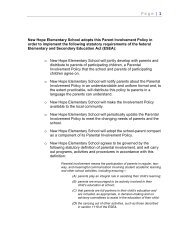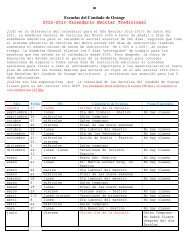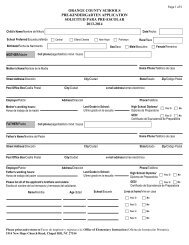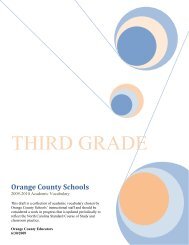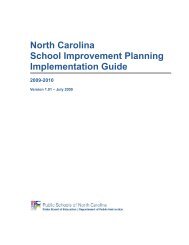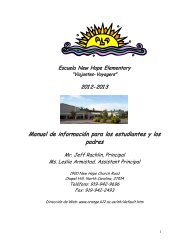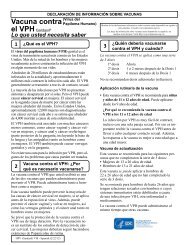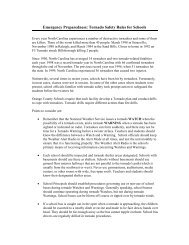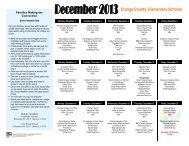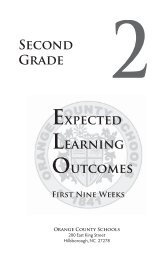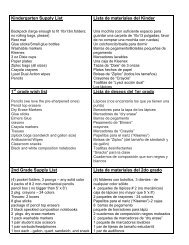Closing the Achievement Gap - Washington State School Directors ...
Closing the Achievement Gap - Washington State School Directors ...
Closing the Achievement Gap - Washington State School Directors ...
Create successful ePaper yourself
Turn your PDF publications into a flip-book with our unique Google optimized e-Paper software.
“Where <strong>the</strong>re are differentlevels of exposure to readingin <strong>the</strong> pre-school years,basic literacy can catch upin school. The more complexaspects of literacy are muchmore difficult to catch upand children with low socioeconomicstatus (SES) fallbehind faster. Pre-schoolliteracy efforts require morethan decoding skills: richoral language opportunities,extended conversations;and exposure toreading. There is a correlationbetween SES andexposure to a rich languageenvironment. Kids musthave wide access to books,print media, writingexperiences and o<strong>the</strong>rexpressive activities, plusdecoding skills.”— Novick and CarrNorthwest RegionalEducational Laboratories(www.nwrel.org)school grant to allow Mead Middle <strong>School</strong> to accelerate <strong>the</strong> creation ofsmaller, more individualized teaching and learning environments. Twoschools are emerging—one alternative district-wide school for students withspecial circumstances, and one “new” middle school.Royal Middle <strong>School</strong> (www.royal.wednet.edu), in rural Grant County, isreinventing itself with a focus on reading and is creating a personalizedlearning plan for every student. The school is ensuring that each studenthas <strong>the</strong> attention of a caring adult by starting an adult advocate/mentorprogram. Students will have <strong>the</strong> same mentor group throughout <strong>the</strong>ir threeyears in middle school.Readiness <strong>Gap</strong> and Early InterventionSuccess in school is influenced by numerous factors including whathappens before children come to school and what occurs while <strong>the</strong>yare in school. “While <strong>the</strong> board’s legal responsibility is to <strong>the</strong> K-12system, <strong>the</strong>re is a large body of research that suggests higher levels ofachievement will not be possible for all students if we limit our focus towhat happens in school.” (Brumbaugh,1997). Researchers report thatmany minority and disadvantaged students enter kindergarten developmentallybehind <strong>the</strong>ir peers and that gaps in achievement grow as <strong>the</strong>y continuein school. According to <strong>the</strong> National Association for <strong>the</strong> Education ofYoung Children, a five-year difference in literacy related skills exists amongchildren entering kindergarten with some children already independentreaders and o<strong>the</strong>rs having <strong>the</strong> skills of a typical three-year old.To address this readiness gap, school boards need to work to extend highquality,academically focused early childhood education to children at-riskof school failure. <strong>School</strong> boards can advocate and partner with communityagencies to get more children of color and low-income families participatingin pre-kindergarten programs. Priority should be on language and readingskills targeting preschool through primary age children. The earlier <strong>the</strong>intervention, <strong>the</strong> more likely <strong>the</strong> achievement gap for individualchildren will be closed.In addition, policies that support full-day kindergarten can provide aneffective early intervention when targeted at meeting <strong>the</strong> needs of studentswho enter kindergarten not having had quality preschool experiences orenriched language stimulation (Hopkins and Katims, 2002). A longitudinalstudy of a full-time kindergarten program in six Edmonds schools fundedby <strong>the</strong> Better <strong>School</strong>s Fund was conducted by Hopkins and Katims whofound that “for all 17 skills measured, a higher percentage of first-gradestudents who had previously attended a full-time kindergarten met orexceeded target than students who had previously attended a half-timekindergarten program.”(page 13.) These differences continued when <strong>the</strong>students were given <strong>the</strong> second grade oral reading assessment a year later.36CLOSING THE ACHIEVEMENT GAP: A POLICY ACTION GUIDE




